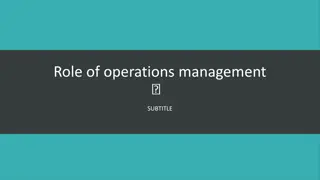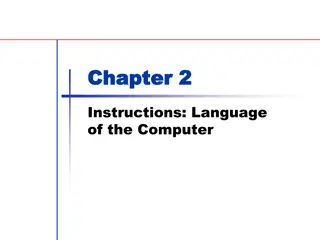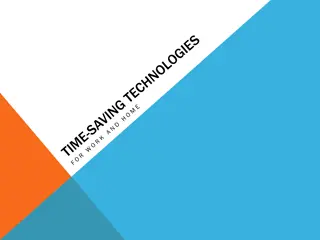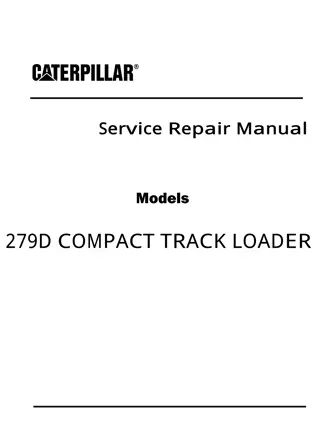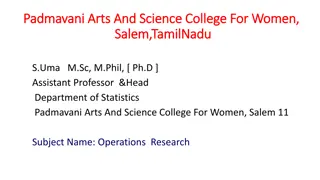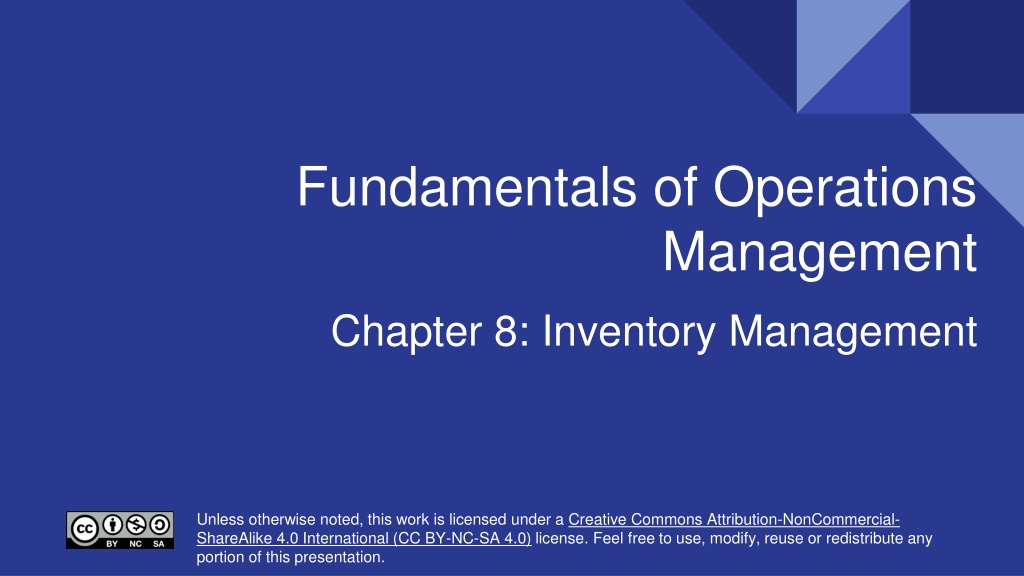
Understanding Inventory Management: Types, Reasons, and Strategies
Discover the fundamental role of inventory management, types of inventory, reasons for maintaining inventory, and strategies to optimize inventory levels. Explore inventory holding costs, order quantity calculations, safety stock, and more.
Download Presentation

Please find below an Image/Link to download the presentation.
The content on the website is provided AS IS for your information and personal use only. It may not be sold, licensed, or shared on other websites without obtaining consent from the author. Download presentation by click this link. If you encounter any issues during the download, it is possible that the publisher has removed the file from their server.
E N D
Presentation Transcript
Fundamentals of Operations Management Chapter 8: Inventory Management Creative Commons Attribution-NonCommercial-ShareAlike 4.0 International (CC BY-NC-SA 4.0) Creative Commons Attribution-NonCommercial-ShareAlike 4.0 International (CC BY-NC-SA 4.0) Unless otherwise noted, this work is licensed under a Creative Commons Attribution-NonCommercial- ShareAlike 4.0 International (CC BY-NC-SA 4.0) license. Feel free to use, modify, reuse or redistribute any portion of this presentation.
8.0 Learning Outcomes In this chapter, we will: Explain the fundamental role of inventory management in balancing customer service levels and inventory costs. Classify and describe the different types of inventory managed by organizations. Analyze the various reasons for maintaining inventory and their impact on inventory management strategies. Identify and explain the components of inventory holding costs and their influence on inventory management decisions. Calculate the optimal order quantity using the EOQ formula and assess its impact on total relevant costs. Apply the EPQ model to determine the optimal production run size and its implications for inventory management. Calculate safety stock and reorder points based on demand variability and service level requirements.
8.1 Introduction to Inventory Management Inventory management is crucial for overseeing material resources that generate future revenue. This responsibility is typically handled by the Operations Manager. In retail, inventory includes goods in both the store and warehouse. Inventory management models address how many units to order and when to place orders. The goal is to balance satisfactory customer service levels with reasonably low inventory costs. There is a trade-off between the amount of inventory held and the level of customer service provided.
8.2 Types of Inventory Understanding and effectively managing these different types of inventory is crucial for organizations to ensure smooth operations, meet customer demand, and maintain optimal inventory levels. Raw materials or purchased parts These are the basic components or materials required for production or assembly processes. Work in process (WIP) or work in progress These are semi-finished or partially completed items found in the middle of assembly lines and manufacturing facilities. Finished goods or merchandise These are the final products ready for sale and distribution to customers, commonly found in retail stores and warehouses. Spare parts, tools, and supplies These are additional inventory items required for maintenance, repair, and operational purposes within the organization.
8.3 Reasons for Maintaining Inventory In-Transit Inventory: Inventory held while in transit, counted as part of the organization's inventory. Leveraging Quantity Discounts: Excess inventory from purchasing in bulk to get supplier discounts. Preventing Stock-Outs: Inventory kept to meet customer demand and avoid stock-outs. Smoothing Production Requirements: Inventory used to maintain steady production levels despite fluctuating demand. Mitigating Operational Disruptions: Inventory maintained to cover for production process disruptions. Cost Considerations: Weighing inventory holding costs against risks of stock-outs and potential savings.
8.3 Reasons for Maintaining Inventory (cont.) Inventory Management Models: Choice of inventory model influenced by demand, lead time, and review time. Lead Time: Review Time: Frequency of monitoring inventory levels, either continuous or periodic. Time between placing an order and receiving goods, crucial for inventory replenishment. Periodic Review: Inventory is checked at fixed intervals, and orders are placed to reach a maximum level based on current stock and demand patterns. Additional Considerations: Factors like perishability or obsolescence complicate inventory models, impacting financial outcomes. Continuous Review: An automated system tracks inventory and triggers reorders when stock reaches a set level, ensuring timely orders.
8.4 Relevant Costs Costs are defined separately for each Stock Keeping Unit (SKU), determining specific order quantities and timing. Total purchasing or acquisition costs refer to the expenditure on procuring an item over a specific period. This cost may remain constant if total demand is unchanged and no quantity discounts are offered. In such cases, the fixed acquisition cost is often excluded from optimization models. If demand or supplier pricing varies, or quantity discounts are available, acquisition costs become variable. Analyzing demand patterns and supplier pricing helps determine if acquisition costs should be fixed or variable in inventory models.
8.4 Inventory Holding Costs Inventory holding costs aim to capture all the actual and opportunity costs incurred by an organization due to maintaining inventory. Financing Costs: Estimated as the cost of borrowing or opportunity cost, proportional to the inventory s value. Storage and Handling Costs: Incurred for physical storage based on item size, not relevant for pipeline inventory. Inventory Risk Costs: Include costs from deterioration, obsolescence, shrinkage, theft, or damage, varying by item type. Insurances: Calculated as a percentage for each item, added to the holding cost percentage. Example Scenario: Consider an item valued at $1,000, and the organization s inventory holding cost is 20% per annum. Annual Holding Cost per Unit: Annual Holding Cost per Unit = Item Value Inventory Holding Cost Percentage Annual Holding Cost per Unit = $1,000 0.2 = $200
8.4 Ordering Costs and Stock-Out Costs The expenses incurred when an organization places an order for inventory replenishment. The economic consequences of running out of stock for a particular item. Stock-Out Costs Lost Sales Costs: Opportunity cost and potential negative impact on goodwill from unfulfilled orders. Backorder Costs: Additional costs for fulfilling delayed orders, including administrative, transportation, and intangible costs. Minimization: Effective inventory management strategies help reduce stock- outs and associated costs. Ordering Costs Administrative: Fixed costs for tasks like preparing purchase orders and obtaining approvals. Transportation: Fixed logistics costs regardless of order size. Receiving: Costs for administrative activities upon order receipt, such as updating records. Reduction: Electronic systems can minimize administrative costs; in production, focus on reducing setup time.
8.5 Economic Order Quantity (EOQ) Model Inventory Control Cycles: Inventory levels increase upon receiving an order and decrease over time due to demand, with a new order placed at the reorder point to prevent stock-outs. Assumptions of EOQ Model: The item is ordered from an external supplier, demand is fixed and known, lead time is constant, a fixed order quantity is placed, and ordering cost is fixed per order. Objective and Cost Components: EOQ aims to find the optimal order quantity (Q*) that minimizes total ordering and carrying costs, excluding acquisition and shortage costs due to fixed demand and no stock-outs. Figure 8.5.1: A diagram showing how the inventory level changes over time
8.6 Economic Production Quantity (EPQ) Inventory Level Fluctuations: Inventory levels fluctuate, increasing during production uptime (T1) at a rate of (p d) units per day and decreasing during downtime (T2) as accumulated stock is used to meet demand, with optimal production lot size and total cost calculated similarly to the EOQ model. Inventory Replenishment Process: The Economic Production Quantity (EPQ) model involves gradual inventory replenishment through internal production, contrasting with the Economic Order Quantity (EOQ) model, where inventory is received in a single batch. Production Setup and Rate Assumptions: The EPQ model includes a production setup cost and assumes the production rate (p) exceeds the demand rate (d) to prevent stock-outs, ensuring a consistent inventory level to meet customer demand. Figure 8.6.1: A chart showing how the inventory level changes over time
8.7 Inventory Models for Uncertain Demand Demand Oscillation and Standard Deviation: Safety Stock Calculation: Reorder Point Adjustment: To account for unexpected changes in market demand, the standard deviation of demand during the lead time ( L) is calculated using the formula where t is the standard deviation of demand per unit time, and L is the lead time: To avoid stock-outs with 95% certainty (Cycle Service Level), the Z value corresponding to the desired service level is multiplied by L to determine the safety stock (SS), reducing the risk of stock-outs: Incorporating safety stock, the new reorder point (ROP) is calculated to ensure sufficient inventory during lead time, combining average demand and safety stock:
Summary & Review Critical Function: Inventory management oversees material resources to ensure future revenue, focusing on balancing customer service levels and inventory costs. Inventory Types: Includes raw materials, work in process, finished goods, and spare parts, maintained to prevent stock-outs, leverage quantity discounts, smooth production, and mitigate disruptions. Relevant Costs: Encompasses purchasing, holding (financing, storage, handling, risk, insurance), and ordering (administrative, transportation, receiving) costs, especially significant for high-value items. EOQ Model: Determines the optimal order quantity that minimizes total costs by balancing ordering and holding costs. EPQ Model and Uncertainty: EPQ model is for internal production, while models for uncertain demand emphasize safety stock and cycle service levels to prevent stock-outs. Comprehensive Strategies: By calculating relevant costs and applying inventory models, organizations can optimize inventory levels, reduce costs, and improve customer service, enhancing operational efficiency and profitability.







